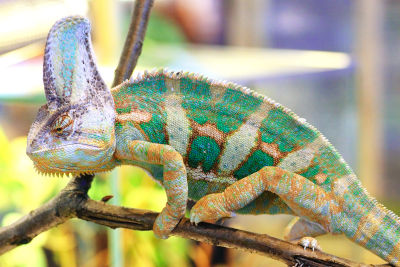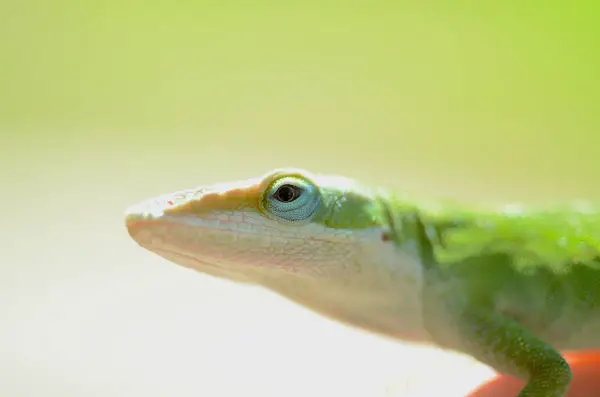Why Do Lizards Change From Green To Brown? (Warning?)
If you have seen a lizard change from green to brown, or you have heard rumors about it, you may be wondering why this happens…
Why do lizards change from green to brown?
Lizards can change from green to brown for several reasons. The main reasons are the temperature, how they feel (mood), and their environment. These species are known for going from green to brown in the Green Anole. It is known to turn brown in cool temperatures and remain green when the temperature is high.
| Are these foods dangerous for your Beardie? | |
| Avacado? Click here to learn, from this guide, if this food is dangerous |  |
| Superworms? Click here to learn, from this guide, if this food is dangerous |  |
So, now you know. But, can brown lizards change to green? What colors can these lizards see? What is the advantage of these color changes? Keep reading for these answers, and much more…
What does it mean when a lizard turns brown?
If your lizard turns brown, and it is specifically a Green Anole, it can mean it is either stressed or at a cool temperature. However, if you find that the temperature seems to be high and it still brown it can suggest it is unhappy and stressed out.
If you fear this is the case you need to look into it. Such as taking it to the vet to make sure it is in good health or for some advice on how to make it feel happier. It could be as easy as making some adjustments in its environment, but it’s best to find out sooner rather than later.
Sometimes lizards may not be happy with their living space. Some owners may get a terrarium that is too small and it could just require more space.
Why do lizards change colors?

A Piebald Chameleon on a branch.
Lizards, in general, change colors for several reasons. Such as their mood, communication, environment, and responses to the temperature. For example, one reason why Chameleons change color is to communicate their stress levels.
If you have assumed that lizards, like Chameleons, simply change their color for camouflage, then this understandable because that is what most people assume and what is portrayed in some adverts. But, in reality, it could be stressed.
If it is stressed, at least it is clear to you from its color rather than other pets that may have subtle behavioral changes that are hard to pick up on.
Can a home lizard change color?
The home lizard, or common house gecko, is not known to change its color. However, during shedding, you may see some changes in color from its old shredded skin to its fresh new one. The lizards most known for actual color change are the Green Anole or chameleon.
As discussed earlier, these lizards are known for changing colors for several reasons such as their mood or temperature. And, these are regarded as true color changes rather than shedding.
What colors do lizards see?
Lizards are known to see a variety of colors and even more vivid than a human eye, especially when it comes to interpreting UV light. However, they also have a parietal eye, known as their third eye, this is known to impact their basking behavior, has the ability to see a couple of colors such as green & blue.
Regarding UV light, a lizard’s view of objects using this light is superior to a human. We humans would need software or cameras to get a true view of what a lizard may see under these lights.
How long does it take for a lizard to change color?
The time for a lizard to change color varies on the situation. For example, a chameleon can change color in 5-10 seconds in some cases. However, during shedding, some lizards may have slight changes in skin color as they strip off their old skin. This can take about 3 days.
However, it is worth noting that shedding and true color changes are quite different. The color changes while shedding, such as the skin getting dull, is just the difference between the old weathered skin and the fresh new skin.
What is the advantage of changing color?

A Green Anole looking to the left.
There are several advantages of a lizard changing color such as attracting a mate or making themselves feel more comfortable when the temperature drops, or even communicating their stress levels.
01. Attracting a mate
Some lizards, such as chameleons will use light colors to help attract a mate. Like most animals in nature, bright vivid colors tend to attract their mates more. This can be beneficial when their main objectives of life are eating, basking, and multiplying.
02. Feeling comfortable during cool temperatures
When the temperature levels drop some lizards, like Green Anoles, will change color to brown to make them absorb more heat and go back to their light green color when its high temperature to reflect the heat. This is advantageous when the temperatures fluctuate quite a lot through the daytime.
Because lizards are cold-blooded, meaning they cannot control their body temperature internally, like us humans. The ability to change color is beneficial for them.
03. Communicating stress levels
Another benefit of changing colors is reflecting their stress levels. Meaning, if they feel stressed they can show a dull color. This tactic is known to be used by chameleons as well as Green anoles.
As humans, we can portray our feeling by our facial expressions. But, lizards can use this technique to make it clear that they need attention or even a sign to other lizards.
Do chameleons know they change color?
It is believed that chameleons know they can change their color. But, the process is believed to be done subconsciously. For example, as humans, if we are embarrassed, some people may go red. This is not done on purpose, or consciously, but it is a noticeable color change that the person is usually aware of.
Therefore, if you have a chameleon and you are hoping to make it change colors on demand you may have a long wait. Their mood change could be unpredictable making this on-demand expectation difficult, if not impossible.
Can a chameleon turn purple?
Some chameleons cannot turn purple. For example, green chameleons, or red panthers are not believed to have the ability to turn purple. So, the range of colors that they can change depends on the type of chameleon you have.
The reason why some people assume all chameleons can turn purple, or other bright colors, is the exaggerated colors displayed in adverts or movies. They may exaggerate the colors for effect or to emphasize their advertising angle. Yes, it’s fun in an advert but not the same when you have a real chameleon in front of you.
Can a brown Anole turn green?
A brown Anole cannot change to green. However, a green Anole can turn brown. Brown Anoles do have the ability for some slight color changes such as gray or black. Like green anoles, they can change color to reflect their mood or temperature changes.
So, if you have a brown anole and were hoping it could switch colors to green you will not be in luck. But, as discussed, they do have some ability to change colors.